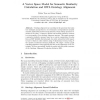158
Voted
DEXA
2006
Springer
15 years 2 months ago
2006
Springer
In recent years, many emerging database applications deal with large sets of continuously moving data objects. Since no computer system can commit continuously occurring infinitesi...
106
Voted
DEXA
2006
Springer
15 years 2 months ago
2006
Springer
Indexing high-dimensional data for efficient nearest-neighbor searches poses interesting research challenges. It is well known that when data dimension is high, the search time can...
95
Voted
DEXA
2006
Springer
15 years 2 months ago
2006
Springer
Abstract. Due to the wide-spread use of decision support systems (DSS), methods are required by software companies. Several concepts and methods have been suggested for decision-ma...
132
Voted
DEXA
2006
Springer
15 years 2 months ago
2006
Springer
Classifying and mining noise-free web pages will improve on accuracy of search results as well as search speed, and may benefit webpage organization applications (e.g., keyword-bas...
103
Voted
DEXA
2006
Springer
15 years 2 months ago
2006
Springer
Geographic information systems (GIS) must support large georeferenced data sets. Due to the size of these data sets finding exact answers to spatial queries can be very time consum...
92
Voted
DEXA
2006
Springer
15 years 4 months ago
2006
Springer
111
Voted
DEXA
2006
Springer
15 years 4 months ago
2006
Springer
Abstract. Workflow Management Systems (WFMS) coordinate execution of logically related multiple tasks in an organization. A workflow schema is defined using a set of tasks that are...
122
Voted
DEXA
2006
Springer
15 years 4 months ago
2006
Springer
Recent work on continuous queries has focused on processing queries in very large, mobile environments. In this paper, we propose a system leveraging the computing capacities of mo...
104
Voted
DEXA
2006
Springer
15 years 4 months ago
2006
Springer
Abstract. Latent Semantic Indexing(LSI) has been proved to be effective to capture the semantic structure of document collections. It is widely used in content-based text retrieval...
117
Voted
DEXA
2006
Springer
15 years 4 months ago
2006
Springer
Ontology alignment (or matching) is the operation that takes two ontologies and produces a set of semantic correspondences (usually semantic similarities) between some elements of ...





